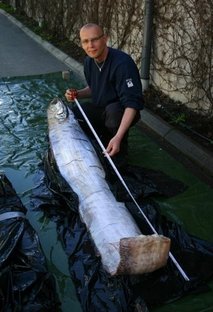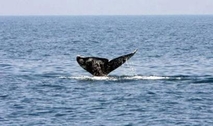Gray Whale Off Israel: First In 200 Years! Oarfish Off Sweden: First in 130 Years!
Posted by: Loren Coleman on May 12th, 2010

First, word reached us that a photograph had been taken of a killer whale off Massachusetts, in the Gulf of Maine, in April 2010.
Well, now have been the unexpected finding of an oarfish, the first in 130 years off the coast of Sweden.

A “giant herring” measuring 3.5 metres (11.4 feet) has been discovered off Sweden’s western coast — the first such fish found in the Scandinavian country in more than 130 years, a maritime museum said on May 11, 2010. Regalecus glesne, known as the King of Herrings or Giant Oarfish, was found dead in the small fishing village of Bovallstrand on Sweden’s west coast, about 90 kilometers (56 miles) from the Norwegian border.
Also today are reports of a gray (or grey, in Europe) whale (Eschrichtius robustus) seen in the Atlantic, which are causing waves of excitement, far and wide, among marine mammal authorities.

A handout picture made available by the Israeli Marine Mammal Research and Assistance Center (IMMRAC) shows a grey whale off the coast of Israel. The appearance of the grey whale off the coast of Israel has stunned scientists, in what was thought to be the first time the giant mammal has been seen outside the Pacific in several hundred years.
The appearance of a grey whale off the coast of Israel has stunned scientists, in what was thought to be the first time the giant mammal has been seen outside the Pacific in several hundred years.
The whale, which was first sighted off Herzliya in central Israel on Saturday, is believed to have travelled thousands of miles from the north Pacific after losing its way in search of food.
“It’s an unbelievable event which has been described as one of the most important whale sightings ever,” said Dr Aviad Scheinin, chairman of the Israel Marine Mammal Research and Assistance Center which identified the creature.
A population of grey whales once inhabited the north Atlantic but became extinct in the 17th or 18th centuries and has not been seen there since.
The remaining colonies live in the western and eastern sectors of the north Pacific.
“What has amazed the entire marine mammal research community is there haven’t been any grey whales in the Atlantic since the 18th century,” he said. Scheinin said the creature, a mature whale measuring some 12 metres (39 feet) and weighing around 20 tonnes, probably reached the Atlantic through the Northwest Passage, an Arctic sea route that connects the Pacific and Atlantic oceans and is normally covered with ice.
“Here you have an animal that is supposed to live in the Pacific and because the ice in the Arctic is melting, it managed to get through this corridor near the Bering Strait,” Scheinin told AFP.
The population which lives in the northeastern Pacific normally migrates southwards in around October, heading for warmer waters around the Gulf of California in a huge round trip of at least 5,000 miles (8,000 kilometres).
So when autumn came, this particular grey whale began travelling south, keeping the land mass on the left and heading for the Californian Gulf with the aim of “turning left” into the bay.
But instead, it reached Gibraltar and turned left into the Mediterranean and ended up off the shores of Israel, Scheinin said….
What’s happening? Hold onto your hats, boys and girls. Gather your sails. This 2010 edition of summer in the northern waters could be something else. No telling what will be found or sighted.
About Loren Coleman
Loren Coleman is one of the world’s leading cryptozoologists, some say “the” leading living cryptozoologist. Certainly, he is acknowledged as the current living American researcher and writer who has most popularized cryptozoology in the late 20th and early 21st centuries.
Starting his fieldwork and investigations in 1960, after traveling and trekking extensively in pursuit of cryptozoological mysteries, Coleman began writing to share his experiences in 1969. An honorary member of Ivan T. Sanderson’s Society for the Investigation of the Unexplained in the 1970s, Coleman has been bestowed with similar honorary memberships of the North Idaho College Cryptozoology Club in 1983, and in subsequent years, that of the British Columbia Scientific Cryptozoology Club, CryptoSafari International, and other international organizations. He was also a Life Member and Benefactor of the International Society of Cryptozoology (now-defunct).
Loren Coleman’s daily blog, as a member of the Cryptomundo Team, served as an ongoing avenue of communication for the ever-growing body of cryptozoo news from 2005 through 2013. He returned as an infrequent contributor beginning Halloween week of 2015.
Coleman is the founder in 2003, and current director of the International Cryptozoology Museum in Portland, Maine.










Fascinating. And all so recently. Global Warming or just a lucky coincidence?
While the oarfish and orca sightings are interesting, the gray whale appearance in the eastern Mediterranean Sea is nothing short of astonishing.
The question as to whether it is a relic of the original population of gray whales which at one time were plentiful in the Atlantic, and during the roman era even found in the Med, and have been considered extinct since the 1700s, or if it is a lone vagrant from the Pacific having worked its way through along the arctic coast of North America, or maybe even Eurasia (some speculate this has become easier as of late due to reduced sea ice coverage evidenced by historic warming).
Whales produce lots of DNA and gray whales are particularly conspicuous normally so lets hope a genetic study and comparison with known samples will be able to determine this specimen’s origins.
You might want to add the recent sighting of a manatee in the Eastern Atlantic to the growing list of sightings. Could it be that at long last the marine mammals conservation act is having an effect?
I sure hope so.
Quote from Mr. Coleman above: “The appearance of the grey whale off the coast of Israel has stunned scientists, in what was thought to be the first time the giant mammal has been seen outside the Pacific in several hundred years.”
Coming at this article from an objective point of view, I believe it is crucial to ask the following questions at some stage between documentation and drawing a reasonable conclusion.
1. Why is this happening now?
Potential Answer in Article: Melting ice revealing corridor near the Bering Strait.
2. What attracted it to that particular location?
Potential Answer in Article: Searching for food
3. What happened to the usual food source?
Potential Anwers include competition with other mammals (including human fishermen and women, if applicable), food source is still there and the whale just got lost on a “field trip”, and last on this list (but certainly not on the master list of possibilities) the whale’s source of food is no longer there.
I’m hesitant to even write the last possibility as it is pure speculation but this event is certainly not common and something, or a series of “?” had to click to make this occurence happen at the time of which it did.
Hi Folks
Done a bit of internet searching on records of grey whales in the arctic. The article gives some records of grey whales as far east as Barter Island in the 1950’s near the Canadian arctic. As far as I can see the only thing stopping grey whales entering the Atlantic was ice, remove the ice (as what happened in 2007/8/9) and you will get stragglers.
Thank you for the link to the PDF report romany12. The author has an extensive bibliographical list which only strengthens credibility.
Quote from page 263 of the report (page 7 on the PDF):
“There is evidence that indicates that the grey whale does little or no
feeding while migrating, or in its winter breeding grounds (Scammon
1874, Andrews 1914). Most authorities have commented on the habit of
this species of remaining close to shore and of entering shallow water. All
observations that indicate this, however, refer to the species on migration
or in its breeding grounds. Their food habits in the summer are poorly
known. Evidence that would indicate that they feed in shallow water while
they are in the arctic is not conclusive. Zenkovitch (cited in MacKintosh
1946) found that they were feeding on bottom-living amphipods. Nikulin
(1946) says that they often enter bays and lagoons”.
As with bringing cryptids into the open realm of public acceptance, it seems that when this report was established evidence as the feeding habits of Grey Whales were not conclusive either among scientists. This is a two-sided sword as it increases the accuracy of the result when they are conclusive (hence the term), but they often take a long period of time to reach that stage, remaining somewhat ‘elusive’ when it comes to gathering a unified belief on said topic.